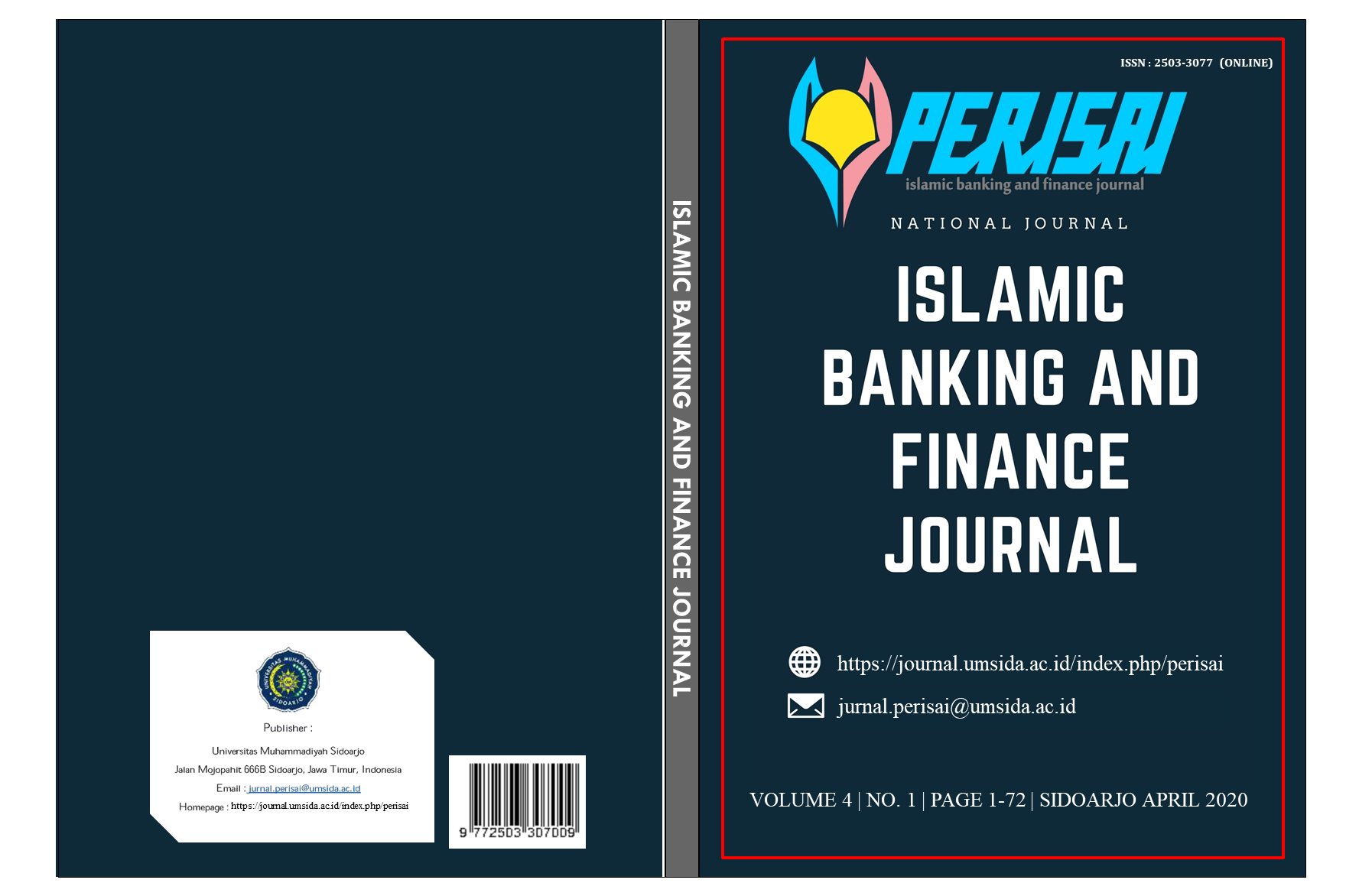The Role of Credit Risk as Mediating the Effect of Liquidity on Sharia Banking Performance
Peran Risiko Kredit Sebagai Pemediasi Pengaruh Likuiditas Terhadap Kinerja Perbankan Syariah
DOI:
https://doi.org/10.21070/perisai.v6i1.1580Keywords:
Liquidity, Credit Risk, Performance, Islamic BankingAbstract
This study aims to examine and analyze the relationship of the influence of liquidity on bank performance mediated by credit risk. Using data on Islamic banking companies listed on the IDX in 2013-2019. The methodology of this research was carried out to achieve the objectives of this study, namely how the influence of liquidity on the performance of Islamic banking companies in Indonesia which is mediated by credit risk. By processing data from data collected from the pre-pandemic and during the pandemic, this research can prove the proposed hypothesis. The analytical tool used is SEM-PLS with WarpPLS 7.0 application. The results of this study indicate that credit risk can partially mediate the relationship between the influence of liquidity on bank performance. This study succeeded in proving that the influence of liquidity on bank performance is acceptable and can be mediated by credit risk. This is in line with the Commercial Loan Theory which explains that providing loans to short-term and productive customers can minimize customer defaults, so that the company's performance will be maintained. During the current pandemic, it is one of the things that makes companies careful in managing liquidity as well as in distributing credit. Banks must be really selective in choosing loans submitted by customers, in order to avoid defaults that cause a decline in bank performance.
References
Ahmad, R. (2016). A Study of Relationship between Liquidity and Profitability of Standard Charterd Bank Pakistan: Analysis of Financial Statement Approach. Global Journal of Management and Business Research: C Finance, 16(1), 76–82.
Ahmed, H. (2015). Basel III liquidity requirement ratios and Islamic banking. Journal of Banking Regulation, 16(4), 251–264. https://doi.org/10.1057/jbr.2014.20
Azmat, S., Azad, A. S. M. S., Ghaffar, H., Hayat, A., & Chazi, A. (2020). Conventional vs Islamic banking and macroeconomic risk: Impact on asset price bubbles. Pacific Basin Finance Journal, 62(October 2019), 101351. https://doi.org/10.1016/j.pacfin.2020.101351
Baron, R. M., dan D. A. Kenny. 1986. "The moderator–mediator variable distinction in social psychological research: Conceptual, strategic, and statistical considerations". Journal of personality and social psychology, Vol. 51, No. 6, hlm: 1173.
Bourke, P. (1989). Concentration and other determinants of bank profitability in Europe, North America and Australia. Journal of Banking and Finance, 13(1), 65–79. https://doi.org/10.1016/0378-4266(89)90020-4
Chamberlain, T. W., Hidayat, S., & Khokhar, A. R. (2018). Credit Risk in Islamic and Conventional Banking. International Advances in Economic Research, 24(1), 99–100. https://doi.org/10.1007/s11294-018-9666-z
Huang, Z., & Pan, H. (2016). A Study on the Impact of Capital Structure of China’s Listed Commercial Banks on Profitability. Management & Engineering, 22(22), 65. https://doi.org/10.5503/J.ME.2016.22.013
Lartey, V. C., Antwi, S., & Boadi, E. K. (2013). The Relationship between Liquidity and Profitability of Listed Banks in Ghana. International Journal of Business and Social Science, 4(3), 48–56.
Lassoued, M. (2018). Comparative study on credit risk in Islamic banking institutions: The case of Malaysia. Quarterly Review of Economics and Finance, 70, 267–278. https://doi.org/10.1016/j.qref.2018.05.009
Masood, O., Al Suwaidi, H., & Darshini Pun Thapa, P. (2012). Credit risk management: a case differentiating Islamic and non-Islamic banks in UAE. Qualitative Research in Financial Markets, 4(2–3), 197–205. https://doi.org/10.1108/17554171211252529
Mohanty, B. K., & Krishnankutty, R. (2018). Determinants of profitability in Indian banks in the changing scenario. International Journal of Economics and Financial Issues, 8(3), 235–240. http:www.econjournals.com
Paleni, H., Hidayat, S., & Dadang Prasetyo, J. A. T. M. I. K. O. (2017). Determinants of profitability: Evidence from Indonesian firms. International Journal of Economic Perspectives, 11(3), 1049–1057.
Rifki, I. (2010). The Management of Liquidity Risk in Islamic Banks: the Case of Indonesia. Durham Theses, Durham University, 264.
Safitri, J., Kadarningsih, A., Din, M. U., & Rahayu, S. (2020). the Effect of Credit Risk As a Mediator Between Liquidity and Capital Adequacy on Bank Performance in Banking Companies Listed on the Idx. Jurnal Penelitan Ekonomi Dan Bisnis, 5(2), 152–161. https://doi.org/10.33633/jpeb.v5i2.3550
Safitri, J., Taolin, M. L., & Prasilowati, S. L. (2020). Inclusion of Interest Rate Risk In Credit Risk On Bank Performance : Evidence In Indonesia. Jurnal Riset Akuntansi Dan Perpajakan, 7(1), 13–26.
Safitri, J., Shaferi, I., Ershaid, A., Nusair, S., & Affandi, M. A. (2021). Original Research Article The Role of Noan Performing Financing (NPF) as A Mediator for The Relationship Between Operating Expenses and Operating Income (BOPO) on The Performance of Islamic Banks in Indonesia. Perisai Islamic Banking and Finance Journal, 5(April), 110–122. https://doi.org/10.21070/perisai.v5i1.1349
Shehu, E. (2016). Determinants of Efficiency in Albanian Banking Industry; an Empirical Diagnosis. CBU International Conference Proceedings, 4(2015), 098–105. https://doi.org/10.12955/cbup.v4.749
Slovin, M. B., & Suskha, M. E. (1983). A Model of the Commercial Loan Rate. The Journal of Finance, 38(5), 1583–1596. https://doi.org/10.1111/j.1540-6261.1983.tb03842.x
Tobin, J. (1958). Liquidity preference as behavior towards risk. Review of Economic Studies, 25(2), 65–86. https://doi.org/10.2307/2296205
Toby, A. J. (2014). Financial Fragility and Performance of Nigerian Banking Institutions: An Inter-Temporal Analysis. Journal of Applied Finance and Banking, 4(6), 137–153. http://search.proquest.com/docview/1621827144?accountid=10297%5Cnhttp://sfx.cranfield.ac.uk/cranfield?url_ver=Z39.88-2004&rft_val_fmt=info:ofi/fmt:kev:mtx:journal&genre=article&sid=ProQ:ProQ%3Aabiglobal&atitle=Financial+Fragility+and+Performance+of+Nigeri
Zaineldeen, M. (2018). Liquidity and Profitability Analysis in the Palestinian Banking Sector. Journal of International Trade, Logistics and Law, Vol 4, Iss 1, Pp 44-53 (2018) VO-4,4(1),44. http://search.ebscohost.com/login.aspx?direct=true&db=edsdoj&AN=edsdoj.6307f862537e49e78b57f3efbb4fa317&site=eds-live&authtype=ip,shib&custid=s9815128.







